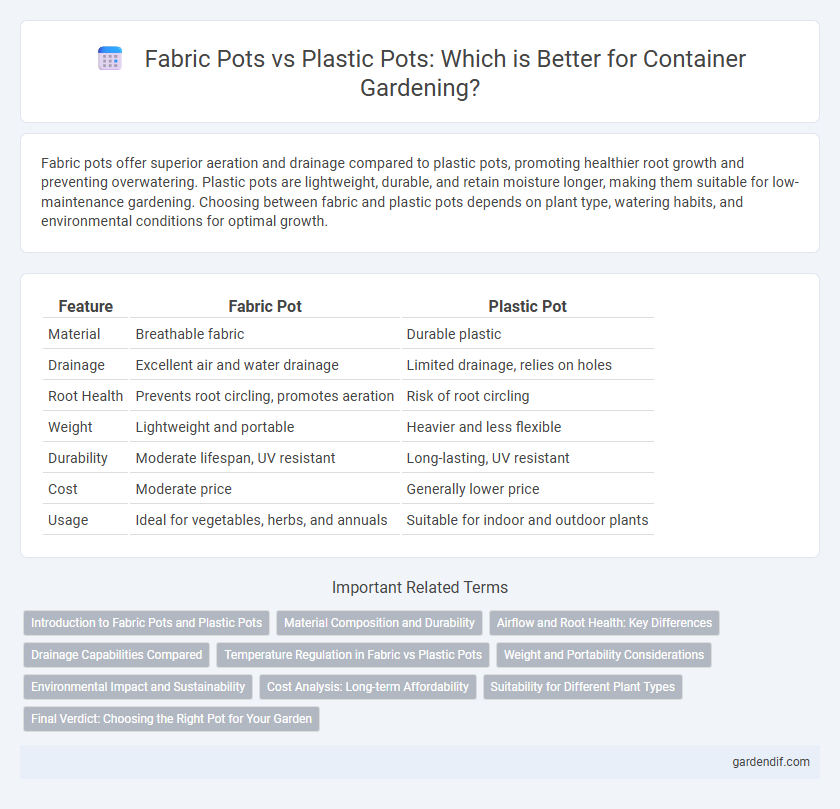
Fabric Pot vs Plastic Pot Illustration
Fabric pots offer superior aeration and drainage compared to plastic pots, promoting healthier root growth and preventing overwatering. Plastic pots are lightweight, durable, and retain moisture longer, making them suitable for low-maintenance gardening. Choosing between fabric and plastic pots depends on plant type, watering habits, and environmental conditions for optimal growth.
Table of Comparison
| Feature | Fabric Pot | Plastic Pot |
|---|---|---|
| Material | Breathable fabric | Durable plastic |
| Drainage | Excellent air and water drainage | Limited drainage, relies on holes |
| Root Health | Prevents root circling, promotes aeration | Risk of root circling |
| Weight | Lightweight and portable | Heavier and less flexible |
| Durability | Moderate lifespan, UV resistant | Long-lasting, UV resistant |
| Cost | Moderate price | Generally lower price |
| Usage | Ideal for vegetables, herbs, and annuals | Suitable for indoor and outdoor plants |
Introduction to Fabric Pots and Plastic Pots
Fabric pots offer enhanced aeration and drainage compared to plastic pots, promoting healthier root development and reducing the risk of overwatering. Plastic pots are lightweight, durable, and retain moisture longer, making them convenient for a variety of plants and environments. Choosing between fabric and plastic containers depends on factors such as plant type, watering frequency, and environmental conditions.
Material Composition and Durability
Fabric pots are made from breathable, non-woven polypropylene material that promotes excellent aeration and root pruning, enhancing plant health and preventing root circling. Plastic pots consist of rigid polypropylene or polyethylene, offering superior water retention and structural solidity, yet they lack airflow and can cause root bound issues. While fabric pots are durable with flexible, tear-resistant fibers suitable for multiple seasons, plastic pots tend to last longer under harsh environmental conditions but may crack or fade with prolonged UV exposure.
Airflow and Root Health: Key Differences
Fabric pots enhance airflow through breathable materials, promoting oxygen exchange and preventing root suffocation compared to plastic pots. Their porous structure facilitates superior drainage, reducing the risk of waterlogging and root rot commonly associated with plastic containers. Improved aeration in fabric pots supports healthier root development and robust plant growth, making them ideal for stress-sensitive crops.
Drainage Capabilities Compared
Fabric pots offer superior drainage capabilities compared to plastic pots, allowing excess water to easily escape through their breathable material, which prevents waterlogging and root rot. Plastic pots often retain water due to limited drainage holes, increasing the risk of overwatering and poor aeration. Effective drainage in fabric pots promotes healthier root development and improves oxygen circulation for optimal plant growth.
Temperature Regulation in Fabric vs Plastic Pots
Fabric pots provide superior temperature regulation by allowing air to circulate through the breathable material, preventing root overheating and promoting cooler soil conditions. Plastic pots tend to retain heat due to their non-porous structure, leading to higher soil temperatures that can stress plant roots. This improved ventilation in fabric containers enhances root health and supports optimal plant growth in warm climates.
Weight and Portability Considerations
Fabric pots are significantly lighter than traditional plastic pots, making them easier to move and ideal for gardeners who frequently rearrange their plants. Their flexible, collapsible design enhances portability, allowing for compact storage and effortless transport during seasonal changes. In contrast, plastic pots tend to be heavier and rigid, which can limit mobility but may provide more structural stability for larger plants.
Environmental Impact and Sustainability
Fabric pots enhance sustainability with their breathable, reusable, and compostable materials, reducing landfill waste and promoting healthier root systems that require less water. Plastic pots, while durable and lightweight, contribute significantly to environmental pollution due to their non-biodegradable nature and limited recycling rates. Choosing fabric pots supports eco-friendly gardening practices by minimizing plastic waste and encouraging soil health through improved aeration and drainage.
Cost Analysis: Long-term Affordability
Fabric pots offer better long-term affordability due to their durability, breathability, and reusability over multiple growing seasons, reducing the need for frequent replacements compared to plastic pots. Plastic pots may have a lower initial cost but tend to degrade under UV exposure and are more prone to cracking, leading to higher replacement expenses over time. Investing in fabric pots can result in cost savings through improved plant health and lower waste management costs associated with plastic disposal.
Suitability for Different Plant Types
Fabric pots offer superior aeration and drainage, making them ideal for plants with sensitive roots such as herbs, tomatoes, and blueberries that require well-oxygenated soil. Plastic pots retain moisture longer and are better suited for water-loving plants like ferns and peace lilies, which thrive in consistently moist conditions. Choosing between fabric and plastic pots depends on the specific water and air requirements of the plant species being cultivated.
Final Verdict: Choosing the Right Pot for Your Garden
Fabric pots offer superior aeration and drainage, promoting healthier root growth and preventing root circling, making them ideal for vibrant, well-established plants. Plastic pots are lightweight, durable, and retain moisture longer, suiting plants that need consistent hydration and low maintenance. Choosing the right pot ultimately depends on your gardening goals, plant type, and environmental conditions to optimize growth and convenience.
Fabric Pot vs Plastic Pot Infographic

 gardendif.com
gardendif.com